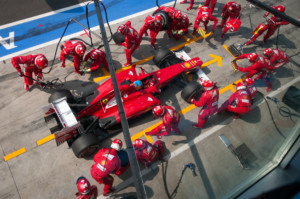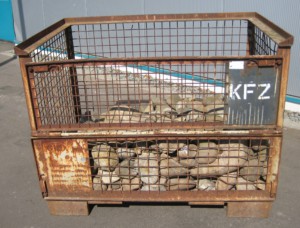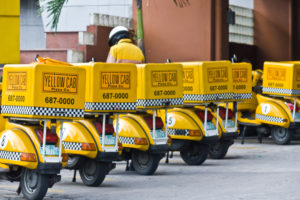 There are a few factors that can influence lot size: machine batch size, changeover time, size of the container, shipment sizes, and the size of your customers’ orders, which then are combined in the set up of the information flow. All of these factors can be influenced to move toward the true north of lot size one! Also, do not confuse the lot size with the number of parts per kanban. They are related but can be different. In this series of three posts, let me explain in more detail how the factors come together for you to determine the lot size of your processes.
There are a few factors that can influence lot size: machine batch size, changeover time, size of the container, shipment sizes, and the size of your customers’ orders, which then are combined in the set up of the information flow. All of these factors can be influenced to move toward the true north of lot size one! Also, do not confuse the lot size with the number of parts per kanban. They are related but can be different. In this series of three posts, let me explain in more detail how the factors come together for you to determine the lot size of your processes.
True North: Lot Size One

The perfect lot size is one. You should always strive to move your production to smaller lot sizes to improve lead time, reduce inventory, and overall become more lean.
But, please, please, don’t just set all lot sizes to zero. That will probably create havoc in your production and may result in a gigantic waste of money. Instead, lot size reduction is a gradual process. You improve your system to allow smaller lot sizes, and then you reduce the lot size, before improving the system even further and allowing even smaller lot sizes.
In fact, some production systems may never achieve lot size one. If you produce standard screws, having a lot size one is highly unlikely. Even a lot size of one package may be difficult. Yet, overall, reducing lot sizes is a move in the right direction. See, for example, my post on Toyota’s and Denso’s Relentless Quest for Lot Size One for some outstanding examples of these efforts. But now let’s look at what can influence your lot size. Important: You do not need a hard number in the first go. Instead, do a lot of back and forth between the different steps to achieve an overall good number.
Changeover Time

Switching from one product type to the next may take time. Ideally, this changeover time is zero, but in many cases it is not. If it is zero, then you can have a lot size of one for this process. If not, you may need to use a larger lot size.
The relation between changeover time and lot size is unfortunately not simple. Accountants and their lean-incompatible accounting prefer to maximize the lot size. The bigger the lot size, the fewer changeovers you need, and the more time you can use productively. Unfortunately, there’s no way to measure the benefit of flexibility, and hence people usually assume this benefit to be nonexistent.
There are mathematical approaches to determine the ideal lot size based on your changeover time, but none that I really trust. The math may ignore factors, make (often hidden) assumptions, and overall may not be worth the effort.
A much better approach is to take the available working time, subtract the time needed to produce the parts (including breakdowns, etc.), and then use the remaining time to do as many changeovers as possible to minimize the lot size. (Remember the true north from above: lot size one is the goal.) This is much better than the accountant’s approach, but it also suffers from the flaw that your working time is not a hard number, and neither is your customer demand. However, this is a good starting point.
You can also involve the experts for the processes, such as the foremen and supervisors on the shop floor. They usually know the capabilities of the processes very well. But keep in mind that they often prefer larger lot sizes for similar reasons as the accountants: less unpopular changeover, more production.
Overall, I recommend making a best guess based on all the available inputs, and then going a little bit lower (i.e., round down, or reduce by 10%–30%, etc.). Even for experts it is easy to underestimate the benefits of smaller lot sizes.
And again, your changeover time can be influenced! See my series of posts on SMED for the systematic process of reducing changeover times.
Container Size
Another factor influencing the lot size is the container size. Usually you need to transport your parts, often in a certain box/pallet/container size. How many parts can you fit in your container?
 Often, this may be a dedicated packaging size (i.e., a blister or foam packaging, a bottle crate, or a egg carton). In this case it may be odd to use a different quantity than indicated by the container size.
Often, this may be a dedicated packaging size (i.e., a blister or foam packaging, a bottle crate, or a egg carton). In this case it may be odd to use a different quantity than indicated by the container size.
In other cases this may be more flexible (i.e., a standard industry box, pallet, or pallet cages). In this case you may also choose not to fill it to max capacity.
Again, the size of your packaging can be influenced. If it is a simple box, then you can use smaller boxes. If it is a dedicated size, then you may over time buy smaller sizes.
Shipment Sizes

In a related situation, if you are receiving deliveries from your suppliers, then it may not make sense to send a truck out every time you need a screw. Overall, you can’t get a good trade-off between the shipping cost and the cost (or benefit) of your inventory.
There is a whole field of research concerning economic order quantity (EOQ) – although there are many assumptions that are not really realistic for daily use. The biggest problem is that they can not determine the value of flexibility obtained from small lot sizes.
Customer Order Size

Yet another factor that can influence the lot size is the order size of the customer. But again, this is also fuzzy, and also much less significant than it sounds. Importantly, the “customer” can be both an external customer or an internal customer (i.e., the next production line within your company or plant that takes over your products). But first the theory:
If your customer always orders a certain number of parts, then (theoretically) your lot size does not need to be smaller than this minimum customer order.
Unfortunately, I have a problem with this logic. First of all, I envy anybody who has a customer that always orders the same size. In my experience, this rarely happens. If it happens at all, then it’s probably with a lot size of one, which does not help you much here either.
Secondly, the benefit of smaller lot sizes is not only to serve your customer better, but to also be a better customer to your suppliers. Furthermore, having smaller lot sizes is also beneficial for your suppliers (both external suppliers and internal production lines delivering parts to your processes).
Overall, you should not completely ignore customer order size, but it is probably more of a soft factor that may not have much influence. Also, depending on your relation with your customer, you may also have the possibility of influencing the size of the customer orders. There are many anecdotes of companies that successfully managed to switch their customers from a monthly order to a weekly order (or less) with benefits for both sides.
In my next post I will talk more about the influence of machine batch size, and also some special considerations for the processing industry and administrative processes. So, until then, go out and see if you can reduce your lot sizes!
P.S.: This series of posts is based on a question from Curtis Rosché.
Post Overview:
- How to determine your Lot Size – Part 1: True North, Change over time, container size, shipment size, customer order size
- How to determine your Lot Size – Part 2: Machine batch size, process industry, administrative processes
- How to determine your Lot Size – Part 3: Information Flow: Decoupling and determining the lot size

Thank you on this. I have to show this post to our production planning as they try all thay can to combine orders to one big batch (because our ERP shows to be more efficent due setup times) at the same time sourcing doing all they can to reduce inventory. And i think this is typical on western companies.
Very typical. Standard cost accounting methods have no way of measuring the value of flexibility, and hence they tend towards maximizing the lot size. Very unfortunate. I hope my post(s) help you to convince them otherwise.
Hi Chris,
The approach you describe to determine lot sizes has been promoted already for a long time in the Toyota descriptions and its Lean follow-up texts. I think we discussed it before as well. Although I fully agree with your arguments, and have used the described approach extensively, I just want to make people aware of a few drawbacks to the approach:
When you determine EPEI on a resource level as you describe, you end up having one single EPEI interval for all part types on the resource. Be aware that every individual part type will potentially have a very different production lot quantity depending upon their average demand volume.
For instance, a 5 day EPEI for a part type with a demand of 1 part a day will imply a production lot of 5 parts; the same EPEI for a part type with an average demand of 5 parts/day is a production lot of 25 parts.
Now this in itself is not a problem, but the consequence is. With a similar cycle time, a big difference in production lot size on a production resource implies big differences in the production time of the lots. And with differing cycle times this can result in even more significant differences. This leads to big variations in the waiting time of the lots in the launcher. And this can become problematic as variations in waiting time can accumulate and lead to big delays in replenishment times and ultimately out-of-stock situations.
And as lots have different production times, it is also more difficult to visually oversee, interpret and manage the workload that is accumulated in the launcher of each work center on the shop floor.
And related to the customer order size, I would like to mention that this is exactly why demand leveling (heijunka) is so important. You immediately break down customer order sizes into one so that it doesn’t become a discussion point for production. Clearly production still will have its own challenges in meeting a production lot size of one. And of course, leveling like this when customer orders are, in fact, not leveled does lead to a outgoing time buffer to absorb the differences between the 1×1 production flow and the non-level shipping flow. This is why these are typically absorbed in so-called truck images or truck preparation areas.
For more, see here: http://dumontis.com/2015/09/epei-pull-flow/
Hope this adds to the discussion.
Kind regards, Rob
Hi Rob, many thanks for the extensive comment. Also thanks for pointing out that the lot size can differ for different products. I added this to the third post of this series. Cheers,
Chris